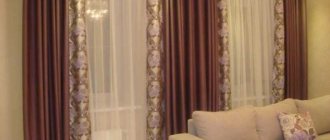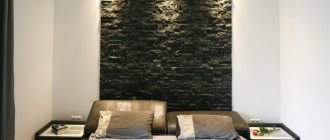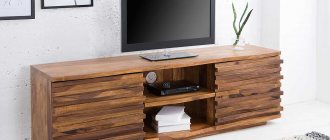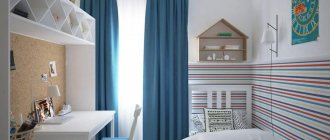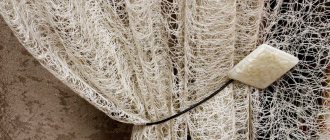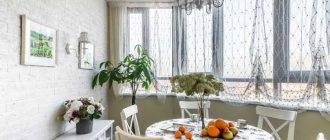Purpose of grabs
Tiebacks in curtain design perform an important decorative function. It is the tiebacks that often become the “highlight” when decorating a window opening: with simple curtains, interesting, bright, original tiebacks look harmonious and appropriate.
In addition, tiebacks perform an important practical function: they beautifully fix the curtains in the open position, allowing sunlight to penetrate into the room.
Design of curtains: tiebacks, ties, pins - which is better
Window design does not end with the purchase of curtains and curtain rods. Even the most exquisite curtains can be missing something.
And this something is precisely a grab or a hairpin. They are able to put an effective point in the design of a room, combine interior details and even change the visual perception of a window opening.
Curtains can be pinned or tied beautifully. Accessories for curtains are sold ready-made or made with your own hands.
Tying, tying or pinning curtains is the easiest way to solve two groups of problems: decorative and functional.
Types of curtain tiebacks
Curtain ties are an interior element, the variety of which simply knows no bounds. Pickups can be:
- fabric;
- magnetic made of glass, wood, metal;
- from a wide variety of materials - leather, brushes, cords, satin ribbons, jewelry...;
- obsolete items - belts, gloves, cutlery, children's toys.
You can easily find a lot of interesting photos of curtain tiebacks on the Internet. Brave designers are ready to use literally everything that is at hand for this small decorative element.
How to choose a pickup
To create a harmonious interior, the material of the curtains and the style of the room are taken into account:
- For light curtains made of tulle, thin cotton or polyester, and thread curtains, magnetic tiebacks, pins, chains, ribbons and ropes are suitable.
- Heavy classic-style curtains are decorated with accessories made of noble fabrics or braided cords with luxurious tassels. They also use solid clamps in brass and bronze with an antique design.
- For Provence and country styles, raw lace, jute twines, flower decor, linen and cotton fabric are suitable.
- Shabby chic is complemented by ribbons, bows and lace in pastel colors.
- For the loft they take forged products, brutal belts and chains.
Attention! The tieback can be the same color as the curtains or a contrasting one. The second option attracts more attention; it is used when it is necessary to emphasize the decoration. It is better to choose a plain accessory for colorful curtains.
Making grabs
The size of the tie depends on the type of fabric from which the curtain is made. For light curtains made of organza, chiffon, polyester, tiebacks with a width of about 20-25 cm will be sufficient. Thicker curtains made of velvet, brocade, blackout require wider tiebacks - 30-40 cm.
In order for the tiebacks to be neat and symmetrical, a pattern is prepared from thick paper or cardboard. Then the pattern is transferred to the fabric and the parts are sewn together. The tiebacks must be carefully ironed or steamed. It is better to add extra stitching for thick fabrics.
Choosing fabric for curtains
Curtains of this type can be made from any fabric of any density that suits the style and intended functions. Curtains, drapes, Roman blinds, and Japanese blinds can be attached to ties.
This type of fastening is used for heavy linen, light cotton, chintz or cambric, characteristic of the Provence style in the interior of a kitchen or country house. Ties made of ribbons or bows can be used for fastening and finishing curtains made of velvet, silk, brocade, tapestry, satin, as well as tulle, veil, organza, used for decorating rooms in the baroque or boudoir style.
This type of fastening is chosen for hanging curtains made of natural fabrics with minimal drapery for an interior decorated in a minimalist style.
If drapery is provided, the fabric should be soft, and the width of the fabric should be 2 times the length of the cornice. The strips should be placed depending on the depth of the intended folds - the further apart they are located, the deeper the sagging will be.
There is no need for curtain tape to hang this type of curtain, but it can be used to create beautiful drapes.
For Roman curtains and blinds, the sagging of which is not intended, thick fabrics are chosen, and the ties are placed close to each other.
Curtains in a cafe or Provence style kitchen are made of cotton fabrics; the ties are attached close to each other to form small and medium folds. Draperies can be formed using curtain tape.
If heavy or transparent linen is chosen for curtains, large, soft draperies can be formed. Such curtains are suitable not only for the kitchen, but also for the bedroom, living room, and children's room.
Curtains made of translucent, lightweight fabrics with ribbon ties are suitable for decorating canopies or draperies in a bedroom interior.
Tieback color
The color scheme of the tiebacks, like them themselves, can be very different. The tiebacks can be made to match the color of the curtain, then they will serve only a functional purpose - to hold the curtain.
Contrasting tiebacks are made from partner curtain fabric, or any other fabric that matches the color. In the kitchen, the scoop can be made in the same color as the tablecloth and potholders, or other bright kitchen utensils. For a child's room, interior elements in pink, soft lilac, if this is a girl's room, tones are suitable.
Tiebacks using gold thread, with fringe and tassels are very formal and would be more suitable for decorating a living room in the appropriate style.
How to tie curtains beautifully
Now that we have both curtains and garters, let's decorate the windows in an original and impressive way.
Double curtain
There are several ways of tying.
- Asymmetric. In this form, the window opening looks unusual and visually wider, especially if you secure them with bright colored garters.
Garters secure curtains at different heights.
- Symmetric. Curtains are tied on both sides at the same height. It looks very cozy and harmonious. If you open the curtains in a semicircle, the atmosphere will be more romantic.
Straight, drawn curtains make the atmosphere strict and formal.
- Angular. The edge of the curtain is folded in the middle and fixed on the wall.
This type of tying gives softness to the entire decoration.
- Cross-shaped. The opposite edges of the curtains are attached to opposite walls.
In this way, two functions are performed: decorative and functional.
Single curtain
Usually such a curtain is tied in the middle. If the product is of calm tones, then the garter is taken in bright, contrasting shades. A harmonious solution would be to gather the curtain on one side only and secure it with a tieback.
It can also be tied at any level with a knot.
For example, to tie curtains beautifully in the kitchen, secure the curtain with a garter on the side where the stove is located. This will add coziness and sophistication to the kitchen space, and also eliminate the possibility of staining or igniting the curtain.
To make everything look harmonious, you need to choose matching ties.
Curtains can also be decorated with decorative braid. The window opening in this case looks attractive and luxurious.
Provence or country style prefers ties with ribbons, lace, bows and bouquet hairpins.
Important! And don’t forget: the more intricate and rich the curtains, the simpler the garters should look. The same rule works in reverse.
Craft option
Making decorative elements with your own hands is a great opportunity to show your imagination and handicraft skills. Embroidery lovers will certainly not miss the opportunity to decorate the interior with an exclusive tieback using beads and beads. Knitted and braided tiebacks are very popular. Macrame weaving techniques are quite simple and do not require much time.
In addition, stores have a fairly large selection of cords and threads of various colors and textures, so making a braided tieback is not at all difficult. The leather grabber looks unusual and stylish. Working with this material requires skill and perseverance, but the result will be an original and one-of-a-kind decorative element.
Various costume jewelry is widely used to make tiebacks. Beads, bracelets, rings made from a variety of materials, glass, wood, leather, metal, are used to decorate curtains quite often and with great success.
Classification by shape and material
This decorative element is a great way to unleash your creativity and decorate your window opening in a unique way. Pickups can be purchased or made by yourself, but in both cases they can be divided into several types:
- Textile - in the form of bows or buttoned.
- Magnetic . There are many types of such jewelry available in the market, they are usually made of metal and are very attractive. Such tiebacks hold fabrics that are not too dense well.
- In the form of a hairpin . An elegant accessory reminiscent of a large hair clip: a round / oval element into which the curtain is threaded, and a rod with which it is secured. Such clamps are made of plastic, wood, and metal.
Pick-up brushes . Such ready-made jewelry of different colors can be found in stores or made by yourself. They add sophistication to the window design. Particularly good for heavy fabrics, such as velvet, jacquard, brocade.- , etc. Such accessories look unusual and help to open the window as much as possible by tucking the fabric into the holder. It’s easy to attach curtain tiebacks to the wall: just buy any holder you like and screw it to the wall on the side of the window at the desired height.
- Holders in the form of beads and chains . You can buy such accessories or make them yourself. They will give the room a special charm.
Beautiful DIY curtain ties with a bow
You can make beautiful curtain ties with your own hands with a luxurious bow that will look very impressive on the window.
Instructions on how to sew tiebacks with a bow for curtains:
- Make a standard pick-up by adding 91.5-115 cm to the base length. And the cut width should be 25.5 cm. Do not tie.
- To keep the bow in front, use a 2.5 x 7.5 cm clip to prevent it from sliding forward. Plus, it will give the curtain a nice, neat edge appearance on the outside of the window.
- Determine the center of the pick-up by folding it in half crosswise and smoothing it lightly with your fingernail. Secure the location of the fold by marking it on the tieback and securing it with a button on the side closest to the window.
- Press the clip into the crease and attach the clip to the window opening or wall using two snaps.
- Wrap the tie back around the curtain and tie a bow.
To secure the bow to the outer edge:
- Find the transverse center of the pick-up.
- Measure from the center a distance equal to half the base length of the pick-up; make a mark on the top edge. Sew a ring at this point.
- Place the ring on the pick-up holder. Wrap the tieback around the curtain. Tie a bow on the outer edge.
Knitted tiebacks
Let's assume there are already curtains, and they have been there for a long time. How to update curtains that are already a little tired. Tiebacks do not require a large amount of yarn and it will not be difficult to knit the most beautiful thing for the windows using leftover yarn, which will also allow you to make a color accent. Here are some ideas:
Many people knit toys. On forums you can find discussions about the use of small treasures. Most craftswomen accumulate toys at home, because the number of friends they give gifts to is finite, but they want to create all the time. Here is a great idea to use for such work. And how pleasing to the eye is the exact copying of the colors of the curtains with a knitted cat.
How to make standard curtain tiebacks with your own hands (with video)
Standard curtain tiebacks are a long piece of fabric attached to a hook or tab on the wall to hold curtains or shades by pulling them back. The rings should be attached so that when the curtains are tied, no rings, hooks or tabs are visible.
Master class on how to make standard curtain tiebacks:
- To make one tieback, cut a strip of fabric equal to the desired length plus 2.5cm, and twice the width of the tieback plus 2.5cm.
- Fold in half lengthwise, right sides facing each other. Sew 12mm from the raw edge, leaving holes for folding. Grabbing the corners, turn them inside out and press them. Sew up the open part using a blind hem stitch.
- On the end that will be closest to the window or wall, sew a ring on the top outer edge.
- At the other end, sew a ring from the inside, 12 mm from the edge.
This video explains in detail how to make standard curtain tiebacks with your own hands:
Decoration with flowers
There are an incredible number of techniques for making flowers. Surely you also know a couple or three of these techniques. And now is the opportunity to use them in interior decor.
Methods for attaching tiebacks
Curtains are thick and lightweight and are held with tiebacks of different shapes and sizes, but they are attached to the wall in different ways. They can be located:
- On the same level as the window sill is the most common option, allowing you to create a harmonious division of the textile fabric. With this arrangement, the flow of street light is evenly regulated.
- 20-30 cm below the window sill level. This method is best suited for thick, heavy curtains. By increasing the length of the curtain in the upper part, a visual narrowing of the window opening occurs. With this arrangement of accessories, textile fabrics cover the window opening more, which means the amount of penetrating street light is reduced. The positive aspects include the ability to hide the shortcomings of the window itself and protect yourself from an unattractive panoramic view.
- Above the window sill line approximately 2/3 from the floor surface. This option for arranging accessories is suitable for curtains up to the length of the window sill or slightly lower, so that most of the window remains open, which contributes to good illumination of the room.
Methods for arranging grabs and holders - part of the window remains open, which contributes to good illumination of the room.
When choosing the optimal mounting method, several factors are taken into account. The height of the room is of great importance. With low ceilings, the window opening must be visually lengthened, and with high ceilings, it must be made wider so that the room visually looks lower.
Mounting options in different rooms
The amount of street light entering the room is also important, which can also be adjusted using special accessories:
- In the living room, hall, hall and children's room, hooks for curtain holders (holders) are mainly located in line with the window sill. In this position the curtains look more harmonious.
- If there is a need to create a darkened environment or there is a desire for privacy, curtain tiebacks are attached to a line below the window sill. This option is most often used in the office or home library.
- In the kitchen, accessories are most often located above the window sill, since short curtains are used to decorate windows. Thanks to this mounting method, the access of street light into the room increases.
The original option is a one-sided arrangement of the pickup and holder. The feasibility of this method is associated with the presence of furniture (walls, cabinets, kitchen units) or a balcony door on the opposite side of the window opening.
How to attach tiebacks
Common options for attaching tiebacks are curtain hooks. They need to be firmly fixed to the wall using a screwdriver. If the wall is brick, concrete, or in a panel house, it is quite possible that drilling will be required. The hook for picking up is placed according to standards at a distance of 0 - 15 cm from the edge of the window slope.
It is important not only to firmly secure the hooks for grabs in the wall, but also to correctly calculate their location.
There is a lot to take into account:
- window dimensions;
- features and disadvantages of a window niche;
- window sill height;
- the ability to hide existing flaws;
- fabric and style of curtains;
- fastening level;
- type of room.
Correctly and securely fastened holders will serve faithfully to your joy and the beauty of your home.
